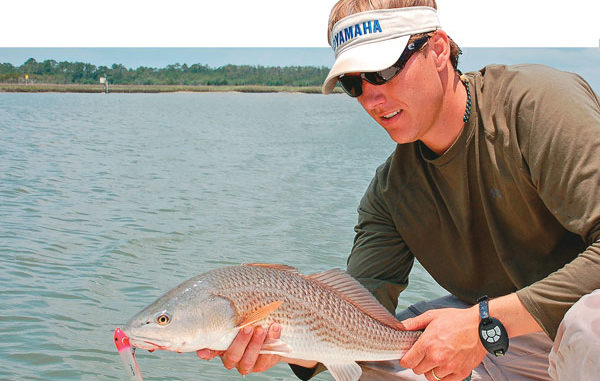
Sneads Ferry and New River make up a fall redfish hotspot like none other along North Carolina’s coastline.
The New River is the only river in North Carolina that begins and ends in the same county, but that’s not the only reason it’s recognized. Fall fishing on the watercourse should get it plenty of notice, and with good reason.
Several metric tons of savory shrimp annually congregate and flood the river’s shallow estuaries, fueling a fabulous fishery. In fact, enough shrimp convene there every fall to serve shrimp cocktail to the entire state of Rhode Island.
The village of Sneads Ferry holds its “Shrimp Festival” every fall, but fishermen feel like the it should be a “Redfish Festival.” Fishing for puppy drum is nothing less than spectacular under fall conditions when the bumper crop of shrimp arrives.
Redfish await the arrival of these tasty crustaceans and will eventually gather into schools, gorging themselves on the divine groceries. While North Carolina’s coastline has a number of great places to catch reds, few compare to the New River.
September may appear to be a little “early” for fall fishing, but autumn begins the third week of the month, and it doesn’t take seasonal weather conditions long to change from summer to fall. Regular cold fronts and a shift of prevailing winds to the north will chill waters quickly. That pushes baitfish and shrimp into large gatherings, which in turn gets the redfish’s attention. Just like the peak of the rut for deer hunters, reds become unbuckled ambushing shrimp on the flats and packing their bellies full.
The river’s geographical features shape the fishery, to some extent. The majority of the New River system lacks significant deep water, so any change in depth and available structure offers predators with ideal locations for an ambush. That keeps shrimp and other forage species on the move all the time, forcing fishermen like Capt. Walter Bateman of Coastal Carolina Guide Service to start searching as soon as the sun breaks the horizon.
“They are here one day and gone the next. You’ve got to stay on them to consistently catch fish,” said Bateman (910-262-1550).
Capt. Ricky Kellum, aka the “Speckled Specialist,” patrols the New River daily, standing as tall as he can with eyes wide open looking for clues that help him follow the movements of bait and reds.
“We ride the river early in the morning looking for schools of reds crashing bait or looking for bait scattering across the surface,” said Kellum (910-330-2745), who looks for reds pushing bait up to the bank or across shallow shoals.
“If the fish are there, the activity on the surface will give away their presence, but wind can be problematic,” Kellum says. “Windy conditions prohibit us from seeing the schools of fish from a distance.”
Kellum targets shoals and points along the leeward banks in fall. With prevailing winds out of the north in fall, the northern banks of the river offer better opportunities to see fish stirring near the surface.
“Ideally, calm winds are preferred when searching for reds,” said Kellum, who is able to see the river from bank to bank on windless days. “On calm days, you can even hear the reds busting bait from great distances.”
The majority of the river is shallow, but several creeks flow into the main channel, forming shoals at the creek mouths. Bateman targets them and the adjacent points on either side as well.
“French’s Creek, Northeast Creek, and Southwest Creek offer ideal conditions for locating schooling redfish,” he said.
According to Bateman, the section of river between Jacksonville and the Intracoastal Waterway (ICW) will hold redfish throughout the fall, but the larger schools of fish generally frequent the waters between French’s Creek and the ICW. As water temperatures continue to drop, the large schools get even larger as they shadow the shrimp on their migration to the ocean.
Wind affects North Carolina’s coastal rivers in different ways. Winds challenge anglers when trying to locate schooling fish, but steady winds can be beneficial, creating wind tides. The shallow nature and heavily-wooded shorelines of the New River can benefit from wind tides. Bateman prefers prevailing southerly winds.
“The shoreline fishing is much better when south winds blow water into the river. Many more stumps and shoreline structure becomes available habitat for fleeing baitfish and feeding grounds for reds,” he said.
Finding schooling reds in fall has its hurdles to overcome, but lure choice is quite clear. Anything resembling a fleeing shrimp or injured baitfish will trigger a bite. The shallow waters and feeding frenzy offers anglers with ideal conditions for working surface lures. Kellum almost always reaches for a topwater bait when the opportunity presents itself.
“Almost any topwater lure of any color will work when (reds are) schooled up in the shallows, but Rapala’s Skitterwalk is my ‘go-to’ lure in bone or black/gold color,” Kellum said. “It’s a freak that redfish cannot resist when feeding on top!”
When topwater lures fail to trigger a quick strike, other baitfish imitations worked beneath the surface will dupe a redfish cruising the shallows. Kellum prefers 5-inch soft plastics rigged on quarter-ounce jig heads. DOA’s jerkshad and Gulp’s jerkshad in pearl, white and other natural colors, plus Gulp!, DOA, Billy Bay and Storm shrimp imitations.
With so much cover along the banks — stumps, wood, oysters and rubble — heavy braided line is the choice, with 20-pound fluorocarbon as leader material, which should be checked and replaced as needed.

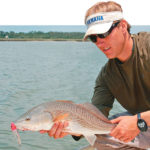
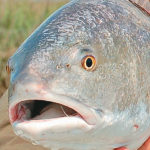
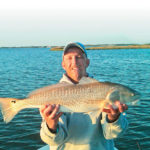
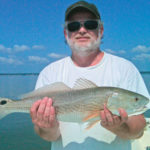
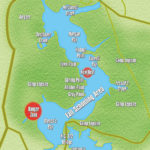



Be the first to comment